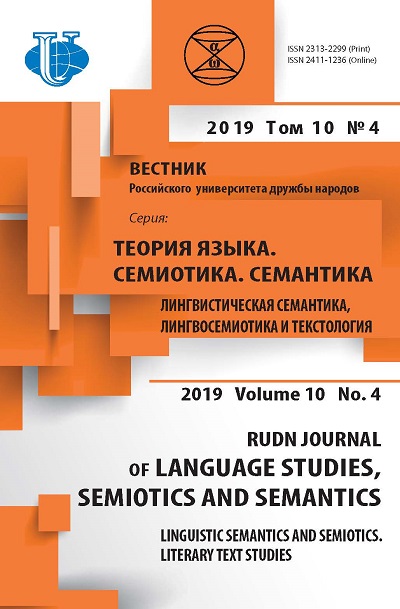The Semantic Space in the Novel of A. Nikolaenko “To kill Bobrykin. The History of one Murder”
- Authors: Strelnikova N.D.1
-
Affiliations:
- Saint-Petersburg State Electrotecnical University “LETI”
- Issue: Vol 10, No 4 (2019): Linguistic Semantics and Semiotics. Literary Text Studies
- Pages: 1088-1105
- Section: LITERARY TEXT SEMANTICS AND POETICS
- URL: https://journals.rudn.ru/semiotics-semantics/article/view/22787
- DOI: https://doi.org/10.22363/2313-2299-2019-10-4-1088-1105
- ID: 22787
Cite item
Full Text
Abstract
In the article the novel “To kill Bobrykin. The history of one murder” by A. Nikolaenko, the 2017 “Russian Buker” prize-winner, is considered as heterogeneous text. The text, semeiotically complicated, is being analyzed through the prism of cultural codes. Different definitions for the concept “cultural code” are given. The semantic space of the novel is various. Iconic works of XX century, to which the author is drawn by the author, -literary texts and screen texts, - are considered as cultural codes. This approach of looking allows to read Nikolaenko novel on other semeiotic level: to trace numerous references, including implicit - to symbolist novel of The Silver Age. In the focus of attention - the interaction and intersection of symbols and meanings.
Keywords
About the authors
Nataliia D. Strelnikova
Saint-Petersburg State Electrotecnical University “LETI”
Author for correspondence.
Email: tashastrel@mail.ru
The head of the Russian language Department of State Electrotecnical University “LETI”, Ph. D. (Philology).
Professor Popov Str., 5, St. Petersburg, Russian Federation, 197376References
- Cultural code [Electronic resource] Wikipedia-version of the encyclopedia in Russian. URL: http: ru.wikipedia.org / wiki/ (accessed: 06/01/2019).
- Khudoley, N.V. (2014). Cultural literary code of the modern Russian reader, Bulletin of Kemerovo State University of Culture and Arts, 29, 155—164.
- Kosikov, G.K. (1989). Roland Barthes — semiologist, philologist. UGT. Article In R. Barth. Selected works: Semiotics: Poetics, G.K. Kosikov (Ed., transl.), Moscow: Progress. pp. 3—45.
- Bart, R. (1989). Selected works: Semiotics: Poetics, G.K. Kosikov (Ed., transl.). Moscow: Progress.
- Intertextual analysis: principles and boundaries: a collection of scientific articles (2018). A.A. Karpov (Ed.), A.D. Stepanov. St. Petersburg: Publishing house of St. Petersburg. un-ta.
- Lotman, Y.M. (2000). Universe Of The Mind. St. Petersburg: Iskusstvo-SPb.
- Pentsova, M.M. The Problem of cultural code in semiotics of Yu.M. Lotman. URL: https://cyberleninka.ru/article/n/problema-kulturnogo-koda-v-semiotike-yu-m-lotmana (accessed: 06/01/2019).
- Krasnykh, V.V. (2001). Codes and standards of culture (invitation to talk). Language, consciousness, communication: collection of articles. Moscow: MAX Press. pp. 5—19.
- See, for example, (2001). Lakoff G., Johnson M. Metaphors We Live By. Chicago, 1990. Language, consciousness, communication: Collection of articles. ed. Moscow: MAX Press.
- Nikolaenko, A. (2018). To Kill Barykina. The story of a murder. Moscow: RIPOLL.
- Zholkovsky, A. (2018). Persistent charm of “Two captains”, New world, 3, 174—192.
- Nabokov, V.V. (2011). Selected. Moscow: AST: Olimp.
- Nikolaenko, A. (2018). Exhale the sun. Alexandra Nikolaenko about the smell of old books, dad-physics, who taught to dream, and Requiem for childhood. Nezavisimaya Gazeta.18.01.2018. URL: www.ng.ru/ng_exlibris/2018-01-18/10_919_nikolaenko.html (accessed: 06/01/2019).
- Kaverin, V.A. (1963). Collected works in 6 vols. Moscow: state publishing house.
- Mayofis, M. How to read “Two captains”. URL: https://www.liveinternet.ru/users/stewardess 0202/post444034069; arzamas.academy/mag/429-2cap (accessed: 06/01/2019).
- Zholkovsky, A.K. lessons of Spanish. In: Zholkovsky A. K. Confrontation with the ruler: Articles about Russian literature. Moscow: Russian state humanitarian University. pp. 358—364.
- Litovskaya, M.A. (2014). Two books “Two captains” In: Russian literature of the XX century: 1930s — mid-1950s in 2 vols. Vol. I. Moscow: Academy. pp. 391—400.
- Oulanoff, Hongor (1976). The Prose Fiction of Veniamin A. Kaverin. Cambridge: Mass., “Slavica”.
- Evgrafova, Yu.А. (2019). Semiotic “matryoshka”: coding in heterogeneous screen texts (on the example of the film text “the King speaks!” and videotext “You're the one you're so”), RUDN Journal of Language Studies, Semiotics and Semantics, 10 (1), 75—84.
- History songs “Paradise” (“City Golden”) (2019). URL: https://song-story/gorod zolotoi (accessed: 15/03/2019).
- Borisov, R. Requiem for childhood from the twilight of love. URL: livelib.ru/book/1002112837-ubit-bobrykina-aleksandra-nikolaenko/ 8 (accessed: 06/01/2019).
- Pasternak, B.L. (1990). Poems and poems: 2. Leningrad: Sovetskij pisatel'.
- Kozhevnikova, N.A. (1976). From observations on non-classical (“ornamental”) prose, Izvestiya an SSSR. Ser. Literatura and yazyk, 1, 55—67.
- Novikov, L.A. (2001). Style and poetics of Andrei Bely's prose In Novikov L.A. Selected works. Aesthetic aspects of language. Miscellanea. Moscow: publishing house of RUDN. pp. 295—485.
- Belyi, A. (1919). About fiction, Gorn, 2—3. Moscow.
- Shklovsky, V.B. (1929). On the theory of prose. Moscow: Federation.
- Baratynsky, E. (1988). Muse In Journey to the country Poetry: in 2 books. Book 1. Leningrad: Lenizdat.
- “I fell into the rhythm of the novel” (2018). Ogonyok. 5. 12.02.2018. 32.; kommersant.ru/ doc/3540438/
- Sologub, F. (1988). The Petty demon. Moscow: Khudozhestvennaya Literatura.
- Barkovskaya, N. (1996). Poetics of the symbolist novel. Yekaterinburg: izdatel'stvo Ural'skogo pedagogicheskogo universiteta.
- Osipova, O.I. (2014). Semiotics of conflict in the novel by F. Sologub “Small demon”, RUDN Journal of Language Studies, Semiotics and Semantics, 3, 27—34.
- Mints, Z.G. (1979). On some “neomiphological” texts in the works of Russian symbolists. In Blokov collection, III, Tartu state University, 459. Tartu. pp. 76—120.
- Gogol, N.V. (1949). Collected works: in six volumes. Vol. 5. Moscow: hudozhestvennaja literature.
- Strelnikova, N.D. (2018). The question of linguistic identity in the novel And Nikolaenko “Kill Barykina. The story of one murder” In Language as a reflection of the spiritual culture of the people: proceedings of the International scientific conference 18—20 October 2018. Arkhangelsk: KIRA. pp. 250—258.
- Strelnikova, N.D. (2015). A.N. Ostrovsky's Play “Bespridannitsa” and its interpretations In Lingvostranovedcheskie, sociocultural and linguistic aspects in the study and teaching of foreign language and literature. Taiwan: Tamkan University. pp. 145—160.
Supplementary files












